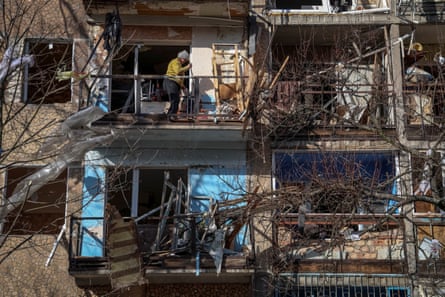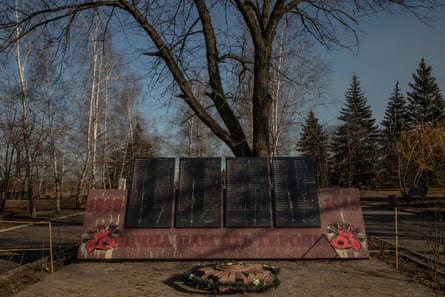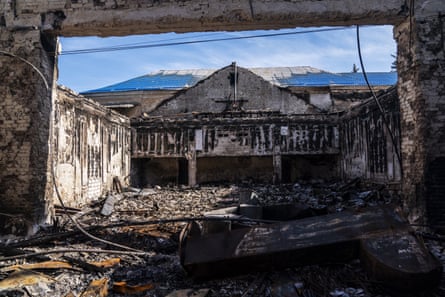Drone team has bombed tanks, armoured fighting vehicles and ammunition dumps but still Russians are on the move
At night, Sasha and his drone team go in search of the enemy. They set off in a dirt-covered vehicle towards the eastern Ukrainian city of Mariinka, occupied by Russia since December. They unload a large drone. And then they fly it in darkness across the frontline, above a ghostly landscape of fields and ruined houses, towards the twinkling city of Donetsk. The drone carries a deadly arsenal of six grenades.
Sasha, who uses the call sign “Tourist”, has bombed more than 100 pieces of Russian military equipment. The list includes tanks, armoured fighting vehicles and self-propelled guns, as well as hidden ammunition dumps. Russian howitzers are another key target. Recently his special operations unit forestalled a large-scale attack. It spotted seven Russian tanks massed for a dawn raid and disabled two of them.
Despite these successes, Ukrainian forces are struggling to hold back the Russians in and around Mariinka and all across the Donbas region. After two years of full-scale war, and last summer’s failed Ukrainian counteroffensive, Moscow is on the move. Its troops captured the city of Avdiivka, next to Donetsk, the provincial capital held by the Kremlin since 2014. Russian reinforcements are taking further territory, village by shattered village.
“The Russians have more of everything. Tanks, artillery, human resources and planes,” Sasha admitted, speaking as he conducted a test flight with his bomb-carrying quadcopter. In the distance, next to a slag heap, black smoke billowed into a white sky. He added: “We have a lot less. And they prepared for this war for a long time. Unfortunately, we didn’t. We can only survive if the west steps up and gives us more weapons.”
Visible nearby was a thermal power plant built alongside a reservoir and the small city of Kurakhove. For the first 18 months after Vladimir Putin’s invasion, Kurakhove was relatively peaceful. Late last year, however, Russia’s army captured the whole of neighbouring Mariinka, edging west. The new frontline runs through the village of Heorhiivka. It is a mere four miles away from Kurakhove’s outskirts.
Recently, Russian warplanes have pounded the city. Last week an aerial glide bomb sliced diagonally into the plant, sending up a giant white mushroom cloud. A Ukrainian soldier sitting underground posted a video showing the moment of impact, capturing a whistle followed by an almighty explosion. His hideout filled with dust. Above ground, apartment blocks and private houses have been smashed.
On Sunday, Russia shelled the city in the morning and hit it with a KAB-500 aerial bomb in the afternoon. According to Kurakhove’s mayor, Roman Padun, 16 people were injured including two children. “One of the injured is in a coma,” he said. The strike blew windows, roofs and facades from seven high-rise buildings. About 4,000 people remain in the city, from an original population of 21,000, ignoring daily requests to leave.

Svitlana, a pensioner, said old people could not afford to move to the city of Dnipro, where rent is expensive. “We don’t have any money. Without that, nobody will take you.” She said she supplemented her meagre pension by selling produce from her cow – milk, cheese and kefir – as well as honey. She added: “We worry that if we abandon our homes, someone will break in and steal our TV and things.”
The mayor said he was afraid Kurakhove faced the same fate as other cities in Donetsk oblast such as Bakhmut. There, Russia flattened everything, planted a flag on the rubble and declared victory. “They are not liberators. They are conquerors,” Padun said. “They make our communities uninhabitable. Kurakhove was beautiful. It was a city of energy. I renovated its schools and parks. Now they target us with inaccurate bombs.”https://interactive.guim.co.uk/uploader/embed/2024/03/ukraine_kurakhove_7mar/giv-13425IfDTuwdoTL21/
Ukraine says it has shot down 15 Russian fighter jets as they took part in bombing missions in February and March. The claim is hard to verify. True or not, Russia enjoys overwhelming air superiority. It continues to launch heavy glide bombs at Ukrainian military positions in frontline areas, and at civilian infrastructure including Kurakhove’s market, bus station and kindergartens. “The strikes happen all the time,” Padun said.
Last week the army spokesperson Dmytro Lykhoviy said the Mariinka area had become another “hotspot” after the fall of Avdiivka and the withdrawal of Ukrainian troops. In the north of Donetsk province, Moscow was trying to seize the towns of Chasiv Yar, Kupiansk and Lyman. Immediately south-west of Kurakhove, fierce battles were taking place, he said. “In two villages the Russians tried to break through our defences 31 times.”
Since 2022, Russian forces have been attempting to seize the well-protected city of Vuhledar. Head-on attempts failed. Russian combat groups have stormed the village of Novomykhailivka in a flanking action. They lost at least 25 armoured vehicles in a 300-metre stretch nicknamed the “road of death”. Nonetheless, these relentless tactics appear to be working. Novomykhailivka is now mostly under Russian control and its capture is likely.
Sasha suggested Russia’s generals were winning because they were prepared to accept huge battlefield casualties, with sometimes hundreds killed and wounded in a single offensive operation. “They send in conscripts to take a machine gun position. All their men are wiped out. But our location is discovered,” he said. “They then call in air support to drop a 500kg bomb on one or two of our guys. There is nothing we can do.”

The drone commander likened Russia’s ruthless president to Machiavelli, the Italian philosopher known for his unscrupulous version of statecraft. “Putin cheats. He wants to get results. He believes the end justifies the means,” he observed. He said democratic Kyiv was fighting against totalitarian Moscow. The outcome of Europe’s biggest war since 1945 would determine which political system, or “pole”, dominated the next century, he predicted.
Video from a night-time operation demonstrates his point. A Russian soldier flees when a drone approaches. It follows and clinically drops a munition. The blast appears to kill the soldier, who can be seen lying on the ground, his rifle by his side. His colleagues try to down the drone. They are killed too. Other night-time footage taken by the unit shows a tank being blown up outside Donetsk, and a fiery detonation from a pile of weapons.
Sasha said he fought in 2014, when Russia began its incursion into Ukraine. He lived in Kyiv, read books on philosophy, and went back to war two years ago. Did he feel guilty about causing so much death?
“To kill is always bad. It doesn’t give me pleasure or joy. Regrettably, it’s necessary. We have to defend our country,” he said. Might he have regrets in the future? “Perhaps. For now we are too busy to suffer from traumatic feelings. We have no time.”
Source: The Guardian




Recent Comments